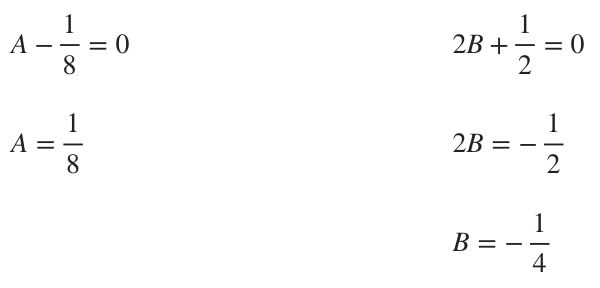Solving differential equation initial value problems with step functions as forcing functions
Four steps to solve an initial value problem when the forcing function is a step function
Sometimes we’ll be given a differential equation in which the forcing function is a step function or includes a step function, and we’ll be asked to solve an initial value problem with the differential equation.
Hi! I'm krista.
I create online courses to help you rock your math class. Read more.
Solving the initial value problem
In general, to solve the initial value problem, we’ll follow these steps:
Make sure the forcing function is being shifted correctly, and identify the function being shifted.
Apply a Laplace transform to each part of the differential equation, substituting initial conditions to simplify.
Solve for ???Y(s)???.
Apply an inverse transform to find ???y(t)???.
As a reminder, when we apply the Laplace transform to the equation in step 2, we’ll often need these transform formulas:
???\mathcal{L}(u_c(t))=\mathcal{L}(u(t-c))=\frac{e^{-cs}}{s}??? (Heaviside function)
???\mathcal{L}(u_c(t)f(t-c))=e^{-cs}F(s)???
???\mathcal{L}(u_c(t)g(t))=e^{-cs}\mathcal{L}(g(t+c))???
Let’s do an example so that we can see how to apply this process to solve an initial value problem when we have a step function in the forcing function.
Solving second-order differential equation initial value problems with step functions as the forcing function
Take the course
Want to learn more about Differential Equations? I have a step-by-step course for that. :)
Example where we rewrite the forcing function
Example
Solve the initial value problem, given ???y(0)=1??? and ???y'(0)=0???.
???y''+4y'=(\sin{t})u(t-2\pi)???
The forcing function could also be written as
???g(t)=\begin{cases}0 \quad\quad 0\le t<2\pi\\ \sin{t} \quad t\ge 2\pi\end{cases}???
Because the step function shows ???c=2\pi???, we need ???f(t)=\sin{t}??? to include a shift of ???2\pi??? as well. We can fix the shift using
???\mathcal{L}(u_c(t)g(t))=e^{-cs}\mathcal{L}(g(t+c))???
So we’ll find
???g(t+2\pi)???
???\sin{(t+2\pi)}???
By the trigonometric identity ???\sin(\theta+\alpha)=\sin\theta\cos\alpha+\cos\theta\sin\alpha???, we can rewrite our sine function as
???\sin{t}\cos{(2\pi)}+\cos{t}\sin{(2\pi)}???
???\sin{t}(1)+\cos{t}(0)???
???\sin{t}???
Then using the Laplace transforms of ???\sin{t}??? and the step function on the right side, the transformed equation becomes
???\mathcal{L}(y'')+4\mathcal{L}(y')=\mathcal{L}(\sin{t}(u(t-2\pi)))???
???s^2Y(s)-sy(0)-y'(0)+4(sY(s)-y(0))=\frac{1}{s^2+1}e^{-2\pi s}???
Substitute the initial conditions ???y(0)=1??? and ???y'(0)=0???, then solve for ???Y(s)???.
???s^2Y(s)-s+4sY(s)-4=\frac{1}{s^2+1}e^{-2\pi s}???
???(s^2+4s)Y(s)-s-4=\frac{1}{s^2+1}e^{-2\pi s}???
???(s^2+4s)Y(s)=s+4+\frac{1}{s^2+1}e^{-2\pi s}???
???Y(s)=\frac{s+4}{s^2+4s}+\frac{1}{(s^2+1)(s^2+4s)}e^{-2\pi s}???
???Y(s)=\frac{s+4}{s(s+4)}+\frac{1}{s(s^2+1)(s+4)}e^{-2\pi s}???
???Y(s)=\frac{1}{s}+\frac{1}{s(s^2+1)(s+4)}e^{-2\pi s}???
Let’s apply a partial fractions decomposition.
???\frac{1}{s(s^2+1)(s+4)}=\frac{A}{s}+\frac{B}{s+4}+\frac{Cs+D}{s^2+1}???
To solve for ???A???, we’ll remove the factor of ???s??? from the denominator on the left side, then set ???s=0???.
???\frac{1}{(s^2+1)(s+4)}???
???\frac{1}{(0^2+1)(0+4)}=\frac{1}{(1)(4)}=\frac{1}{4}???
To solve for ???B???, we’ll remove the factor of ???s+4??? from the denominator on the left side, then set ???s=-4???.
???\frac{1}{s(s^2+1)}???
???\frac{1}{-4((-4)^2+1)}=\frac{1}{-4(17)}=-\frac{1}{68}???
To find ???C??? and ???D???, we’ll expand multiply through both sides of the decomposition equation by the denominator from the left side.
???1=A(s^2+1)(s+4)+Bs(s^2+1)+(Cs+D)s(s+4)???
???1=As^3+4As^2+As+4A+Bs^3+sB+Cs^3+4Cs^2+Ds^2+4Ds???
Substitute the values ???A=1/4??? and ???B=-1/68??? that we already found.
???1=\left(\frac14-\frac{1}{68}+C\right)s^3+\left(4\left(\frac14\right)+4C+D\right)s^2+\left(\frac14-\frac{1}{68}+4D\right)s+4\left(\frac14\right)???
???1=\left(\frac{4}{17}+C\right)s^3+\left(1+4C+D\right)s^2+\left(\frac{4}{17}+4D\right)s+1???
Then equating coefficients gives
???\frac{4}{17}+C=0??? so ???C=-\frac{4}{17}???
???D=-\frac{1}{17}???
Plugging ???A=1/4???, ???B=-1/68???, ???C=-4/17???, and ???D=-1/17??? into the decomposition gives
???\frac{1}{s(s^2+1)(s+4)}=\frac14\left(\frac{1}{s}\right)-\frac{1}{68}\left(\frac{1}{s+4}\right)+\frac{-\frac{4}{17}s-\frac{1}{17}}{s^2+1}???
???\frac{1}{s(s^2+1)(s+4)}=\frac14\left(\frac{1}{s}\right)-\frac{1}{68}\left(\frac{1}{s+4}\right)-\frac{1}{17}\left(\frac{4s+1}{s^2+1}\right)???
So ???Y(s)??? is
???Y(s)=\frac{1}{s}+\left(\frac14\left(\frac{1}{s}\right)-\frac{1}{68}\left(\frac{1}{s+4}\right)-\frac{1}{17}\left(\frac{4s+1}{s^2+1}\right)\right)e^{-2\pi s}???
???Y(s)=\frac{1}{s}+\frac14\left(\frac{1}{s}\right)e^{-2\pi s}-\frac{1}{68}\left(\frac{1}{s+4}\right)e^{-2\pi s}-\frac{1}{17}\left(\frac{4s+1}{s^2+1}\right)e^{-2\pi s}???
???Y(s)=\frac{1}{s}+\frac14\left(\frac{1}{s}\right)e^{-2\pi s}-\frac{1}{68}\left(\frac{1}{s+4}\right)e^{-2\pi s}-\frac{1}{17}\left(\frac{4s}{s^2+1}+\frac{1}{s^2+1}\right)e^{-2\pi s}???
???Y(s)=\frac{1}{s}+\frac14\left(\frac{1}{s}\right)e^{-2\pi s}-\frac{1}{68}\left(\frac{1}{s+4}\right)e^{-2\pi s}???
???-\frac{4}{17}\left(\frac{s}{s^2+1}\right)e^{-2\pi s}-\frac{1}{17}\left(\frac{1}{s^2+1}\right)e^{-2\pi s}???
Then with the inverse transform formula ???\mathcal{L}^{-1}{(e^{-cs}F(s))}=f(t-c)u(t-c)??? that we looked at earlier, the inverse transform is
???y(t)=1+\frac14(1)u(t-2\pi)-\frac{1}{68}(e^{-4(t-2\pi)})u(t-2\pi)???
???-\frac{4}{17}\cos{(t-2\pi)}u(t-2\pi)-\frac{1}{17}\sin{(t-2\pi)}u(t-2\pi)???
???y(t)=1+\frac14u(t-2\pi)-\frac{1}{68}e^{-4t+8\pi}u(t-2\pi)???
???-\frac{4}{17}\cos{(t-2\pi)}u(t-2\pi)-\frac{1}{17}\sin{(t-2\pi)}u(t-2\pi)???
Let’s do another example with an initial value problem.
Make sure the forcing function is being shifted correctly, and identify the function being shifted, then apply a Laplace transform to each part of the differential equation, substituting initial conditions to simplify.
Example
Solve the initial value problem, given ???y(0)=0??? and ???y'(0)=-1???.
???y''+2y'=1+(t-1)u_3(t)???
Remember that each function must be shifted by the appropriate amount. Getting things set up for the proper shifts gives us
???f(t)=1+(t-1)u_3(t)???
???f(t)=1+(t-3+3-1)u_3(t)???
???f(t)=1+(t-3+2)u_3(t)???
So for the Heaviside function, it looks like ???g(t)=t+2??? is the function being shifted. Then the transformed equation will be
???\mathcal{L}(y'')+2\mathcal{L}(y')=\mathcal{L}(1)+\mathcal{L}((t-3+2)u_3(t))???
???s^2Y(s)-sy(0)-y'(0)+2(sY(s)-y(0))=\frac{1}{s}+e^{-3s}\left(\frac{1}{s^2}+\frac2s\right)???
Substitute the initial conditions ???y(0)=0??? and ???y'(0)=-1???, then solve for ???Y(s)???.
???s^2Y(s)+1+2sY(s)=\frac{1}{s}+e^{-3s}\left(\frac{1}{s^2}+\frac2s\right)???
???(s^2+2s)Y(s)+1=\frac{1}{s}+e^{-3s}\left(\frac{1}{s^2}+\frac2s\right)???
???(s^2+2s)Y(s)=\frac{1}{s}+e^{-3s}\frac{1}{s^2}+e^{-3s}\frac2s-1???
???Y(s)=\frac{1}{s(s^2+2s)}+e^{-3s}\frac{1}{s^2(s^2+2s)}+e^{-3s}\frac{2}{s(s^2+2s)}-\frac{1}{s^2+2s}???
???Y(s)=\frac{1}{s^2(s+2)}+2e^{-3s}\frac{1}{s^2(s+2)}+e^{-3s}\frac{1}{s^3(s+2)}-\frac{1}{s(s+2)}???
Apply a partial fractions decomposition to the first fraction, which is the same decomposition we’ll use for the second fraction.
???\frac{1}{s^2(s+2)}=\frac{A}{s}+\frac{B}{s^2}+\frac{C}{s+2}???
To find ???C???, remove the factor of ???s+2??? from the left side, then substitute ???s=-2???.
???\frac{1}{s^2}\to\frac{1}{(-2)^2}\to\frac{1}{4}???
To find ???B???, remove the factor of ???s^2??? from the left side, then substitute ???s=0???.
???\frac{1}{s+2}\to\frac{1}{0+2}\to\frac{1}{2}???
To find ???A???, substitute ???B=1/2??? and ???C=1/4???, and any value we haven’t already used for ???s???. We’ve already used ???s=-2,\ 0???, so we’ll choose ???s=1???.
???\frac{1}{1^2(1+2)}=\frac{A}{1}+\frac{\frac12}{1^2}+\frac{\frac14}{1+2}???
???\frac{1}{3}=A+\frac12+\frac{1}{12}???
???A=\frac{4}{12}-\frac{6}{12}-\frac{1}{12}???
???A=-\frac14???
So the decomposition is
???\frac{1}{s^2(s+2)}=\frac{-\frac14}{s}+\frac{\frac12}{s^2}+\frac{\frac14}{s+2}???
Replacing the first and second fractions in ???Y(s)??? with this decomposition gives
???Y(s)=\frac{-\frac14}{s}+\frac{\frac12}{s^2}+\frac{\frac14}{s+2}+2e^{-3s}\left(\frac{-\frac14}{s}+\frac{\frac12}{s^2}+\frac{\frac14}{s+2}\right)???
???+e^{-3s}\frac{1}{s^3(s+2)}-\frac{1}{s(s+2)}???
Apply a partial fractions decomposition to the third fraction.
???\frac{1}{s^3(s+2)}=\frac{A}{s}+\frac{B}{s^2}+\frac{C}{s^3}+\frac{D}{s+2}???
To find ???D???, remove the factor of ???s+2??? from the left side, then substitute ???s=-2???.
???\frac{1}{s^3}\to\frac{1}{(-2)^3}\to-\frac{1}{8}???
To find ???C???, remove the factor of ???s^3??? from the left side, then substitute ???s=0???.
???\frac{1}{s+2}\to\frac{1}{0+2}\to\frac{1}{2}???
To find ???A??? and ???B???, multiply through both sides of the decomposition by the denominator from the left side.
???1=As^2(s+2)+Bs(s+2)+C(s+2)+Ds^3???
Substitute the values ???C=1/2??? and ???D=-1/8??? that we already found.
???1=As^2(s+2)+Bs(s+2)+\frac12(s+2)-\frac18s^3???
???1=As^3+2As^2+Bs^2+2Bs+\frac12s+1-\frac18s^3???
???1=\left(A-\frac18\right)s^3+(2A+B)s^2+\left(2B+\frac12\right)s+1???
???0=\left(A-\frac18\right)s^3+(2A+B)s^2+\left(2B+\frac12\right)s???
Equate coefficients from the first and third terms to find ???A??? and ???B???.
So the decomposition is
???\frac{1}{s^3(s+2)}=\frac{\frac18}{s}+\frac{-\frac14}{s^2}+\frac{\frac12}{s^3}+\frac{-\frac18}{s+2}???
Replacing the third fraction in ???Y(s)??? with this decomposition gives
???Y(s)=\frac{-\frac14}{s}+\frac{\frac12}{s^2}+\frac{\frac14}{s+2}+2e^{-3s}\left(\frac{-\frac14}{s}+\frac{\frac12}{s^2}+\frac{\frac14}{s+2}\right)???
???+e^{-3s}\left(\frac{\frac18}{s}+\frac{-\frac14}{s^2}+\frac{\frac12}{s^3}+\frac{-\frac18}{s+2}\right)-\frac{1}{s(s+2)}???
Apply a partial fractions decomposition to the fourth fraction.
???\frac{1}{s(s+2)}=\frac{A}{s}+\frac{B}{s+2}???
To find ???B???, remove the factor of ???s+2??? from the left side, then substitute ???s=-2???.
???\frac{1}{s}\to-\frac{1}{2}???
To find ???A???, remove the factor of ???s??? from the left side, then substitute ???s=0???.
???\frac{1}{s+2}\to\frac{1}{0+2}\to\frac{1}{2}???
So the decomposition is
???\frac{1}{s(s+2)}=\frac{\frac12}{s}+\frac{-\frac12}{s+2}???
Replacing the fourth fraction in ???Y(s)??? with this decomposition gives
???Y(s)=\frac{-\frac14}{s}+\frac{\frac12}{s^2}+\frac{\frac14}{s+2}+2e^{-3s}\left(\frac{-\frac14}{s}+\frac{\frac12}{s^2}+\frac{\frac14}{s+2}\right)???
???+e^{-3s}\left(\frac{\frac18}{s}+\frac{-\frac14}{s^2}+\frac{\frac12}{s^3}+\frac{-\frac18}{s+2}\right)-\left(\frac{\frac12}{s}+\frac{-\frac12}{s+2}\right)???
???Y(s)=-\frac14\left(\frac{1}{s}\right)+\frac12\left(\frac{1}{s^2}\right)+\frac14\left(\frac{1}{s+2}\right)???
???-\frac12e^{-3s}\left(\frac{1}{s}\right)+e^{-3s}\left(\frac{1}{s^2}\right)+\frac12e^{-3s}\left(\frac{1}{s+2}\right)???
???+\frac18e^{-3s}\left(\frac{1}{s}\right)-\frac14e^{-3s}\left(\frac{1}{s^2}\right)+\frac12e^{-3s}\left(\frac{1}{s^3}\right)-\frac18e^{-3s}\left(\frac{1}{s+2}\right)???
???-\frac12\left(\frac{1}{s}\right)+\frac12\left(\frac{1}{s+2}\right)???
Then with the inverse transform formula ???\mathcal{L}^{-1}{(e^{-cs}F(s))}=f(t-c)u(t-c)??? that we looked at earlier, the inverse transform is
???y(t)=-\frac14(1)+\frac12(t)+\frac14(e^{-2t})???
???-\frac12u_3(t)(1)+u_3(t)(t-3)+\frac12u_3(t)e^{-2(t-3)}???
???+\frac18u_3(t)(1)-\frac14u_3(t)(t-3)+\frac{1}{2(2!)}u_3(t)(t-3)^2-\frac18u_3(t)e^{-2(t-3)}???
???-\frac12(1)+\frac12(e^{-2t})???
???y(t)=-\frac14+\frac12t+\frac14e^{-2t}???
???-\frac12u_3(t)+u_3(t)(t-3)+\frac12u_3(t)e^{6-2t}???
???+\frac18u_3(t)-\frac14u_3(t)(t-3)+\frac{1}{4}u_3(t)(t-3)^2-\frac18u_3(t)e^{6-2t}???
???-\frac12+\frac12e^{-2t}???
???y(t)=\frac34e^{-2t}+\frac12t-\frac34+u_3(t)\left(\frac38e^{6-2t}+\frac{1}{4}t^2-\frac34t-\frac{3}{8}\right)???







